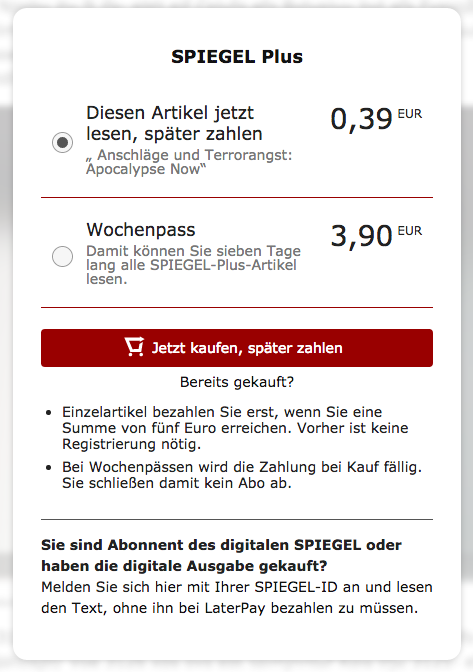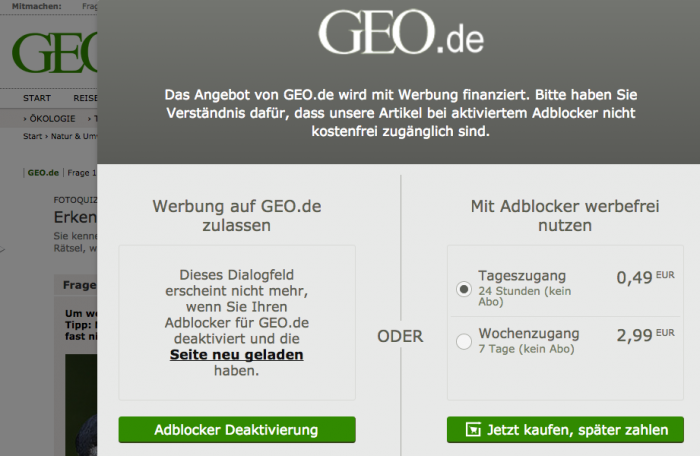
Micropayments, schmicropayments, amirite? For skeptics, any excitement over the pay-per-article model — this mythical iTunes for journalism that the micropayments camp often cites — seems sadly naive. There’s little thus far to convince them that micropayments for news will soon become a driving source of revenue for publishers.
Cosmin Ene has clearly been battling the skepticism for a while, and he has counterarguments at the ready in his pitch for his company LaterPay, with helpful analogies and anecdotes abound. Ene is founder and CEO of the five-year-old Munich-based company, which recently picked up its largest client in weekly news magazine Der Spiegel. Spiegel Online, the print magazine’s digital sibling, implemented for the first time a paid offering on its site, tucking some stories behind a hard paywall. Spiegel Plus stories are visible to all readers, but readers are cut off at 1,000 characters and prompted to pay 39 euro cents for the rest. (Der Spiegel is on the shiny, highly publicized Dutch micropayments startup Blendle as well.)Sounds like your usual micropayment setup, but LaterPay offers a small twist: Readers only actually pay once they hit a total of 5 euros. LaterPay keeps a bar tab of what you’re reading, and takes a cut if you actually end up paying (around 15-25 percent, depending on volume of transactions). Accept the terms and conditions, and read on without logging in — a LaterPay registration page only pops up after five euros-worth of reading. Not reading enough to hit five euros? Those readers pay nothing — and publishers get nothing.
“We are not a wallet. 99 percent of the models out there are wallets. You need to pay up money first, then spend that money with them, within their universe,” Ene said. “We’re bringing back the IOU to the Internet, which is a principle people know and trust. The way the regular pay-per-use model works, you just click on an article, confirm to pay later, and you can read the article immediately. We defer the time when you have to register and pay to a later stage, letting you convince yourself of the content, of the quality of the content, of the benefits that are offered to you.” (Some of the analogies Ene offered up: Going to a conveyor-belt sushi restaurant — or any restaurant, really — and paying after counting up plates eaten. Or going on Tinder and dating around before committing to a relationship. Hmmm.)

According to Ene, LaterPay currently has around 100 clients, ranging from individual bloggers with a dedicated following to smaller publishers to Spiegel Online. In 2014, after pushing to get big publishers on board with its IOU-for-the-Internet idea, it began expanding its services to other industries: “This is not something only works or should work for publishing. It should work for all kinds of content. People can read now, pay later; they can play now and buy in-game items later; they can watch movies now and pay later. Everything that’s measurable in time or in units could be sold with LaterPay,” Ene said.
LaterPay is a payment infrastructure company at its core. Publishers can integrate it either via its API or using a line of JavaScript. There’s a WordPress plugin option. It offers a standard micropayment option (register, log in, pay for a piece of content). It also offers other methods of payment collection to help publishers scoop up some readers who fall somewhere in between dedicated subscribers and one-time visitors who will never consider paying for content. LaterPay’s (micro) time passes allow readers to access a site in customizable time increments — time allowed per price determined by the publisher (this week, Spiegel Online also rolled out the time pass option). Some sites implement a version of these time passes, prompting readers with adblockers turned on to purchase a pass to continue reading. Its new (micro) subscriptions service will also try to extend the pay-later philosophy to readers who are say, only interested in subscribing to the sports section of a full news site. Readers might then pick and choose a number of these subscriptions, piecing together their own personalized online magazines. But doesn’t a platform like Blendle serve essentially the same purpose, with some extra editorial curation and promotion thrown in? Why wouldn’t readers accustomed to free content simply stop just before they hit the five-euro threshold, and never come back?“We’re building the conversion funnel,” Ene said. “For the people starting to use paid content, occasional users can continue with the pay-per-use model, while more loyal users, the ones coming a couple of times a week or a couple of times a day, can jump on the time passes, and once they lose some fear of paying for content, maybe they’ll eventually jump onto subscriptions.”
Of all readers across all LaterPay-activated sites who hit the dialog box, 72 percent agreed to pay later (a.k.a., hit a button to see the rest of the story). Out of those readers, 80 percent ultimately registered and paid, according to Ene.
In the fall, LaterPay plans to expand its services to the U.S., with a few publishers already on board (no names yet, Ene said, because the contracts are still in progress). Currently its clients are mostly in Germany, with a few in Austria. German journalist and media/tech blogger Richard Gutjahr uses the service on his website. Daily tabloid Hamburger Morgenpost charges for some premium content. German tech site Golem, which has a full ad-free membership offering in part to alleviate the side effects of adblocking, offers a version of the LaterPay system to interested readers who might not yet want to be subscribers. Bergedorfer Zeitung is testing LaterPay. And Hamburg-based publisher Gruner + Jahr uses the LaterPay on several of its sites, starting with Geo and expanding to Schöner Wohnen and Living at Home, prompting readers to pay for day or week time passes in order to continue reading with their adblockers (the premise is the same: you pay later when you reach the threshold).
According to Ene, one blogger using LaterPay has made the equivalent of $24,000 in revenue (paid out from users passing the threshold and from users buying time passes). I reached out to several other publishers using a form of LaterPay; none would share numbers on how much they’ve made through LaterPay.

“So far all of our tests have been successful, some with greater effects than others,” Oliver von Wersch, managing director of growth projects and strategic partnerships at G+J, told me in an email. “The LaterPay approach has shown that it has no negative effect on our reach or brand reputation due to giving the user an alternative.” LaterPay is the only payment alternative it’s testing right now, though G+J also pushing anti-adblock tactics around messaging and technical circumventions. “Most of our adblock users deactivate their adblockers instead of buying passes. The test has brought back more than 40 percent of our adblocked traffic.”
Many publishers remain deeply skeptical of any excitement around micropayments, of a belief that readers used to free content might be willing to pay if the cost is low enough and the process easy enough. Ene says he sees LaterPay’s model slightly differently.
“If you ask readers, do they want to access content for free, or do they want to buy a subscription, then, no surprise, a big amount say they want that content for free. There’s even a German word for the ‘no cost’ mentality: Kostenlosmentalität. But I believe there’s no such thing as that. It’s just a lack of adequate models to serve the users the way they want to be served,” he said. “I think the same is true in the U.S. This is a process. It’s not an event. We have invested a lot to create a payment infrastructure to enable content providers to experiment a lot, and find their own way. There is no such thing as a catch-all model that makes everyone happy.”